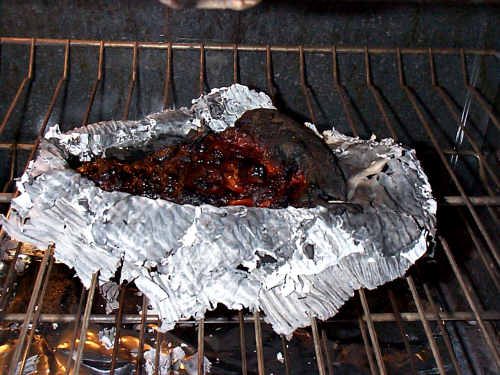A 365-Day Project
"We Are All Mozart"
A project to create
new works and change
the perception of the
music of our time.


 August 28, 2006
August 28, 2006 
I'm thinking about thin things and fat things and big & small things. Sandwiches, mail through a slot, and rain leaking under the door. I'm also thinking about watching baseball and car commercials and grocery shopping. And I'm thinking about medicines and chewable vitamins and cough syrup. Plus pepperoni, anchovies, jalapeños.
These come to mind because each group contains different kinds of emphases and markers. In the first group, it's the thin item that matters. In the second, the fat item matters. In the third, hidden and obvious items matter differently. And in the last, a synergetic relationship rules.
How do we become interested in new nonpop? Each of us finds a way to it, but to find that way, it has to be present. The presence of new nonpop is minimal on radio and in concert, and that presence is similar to the groups above -- but engenders a different character of reaction. The first group takes an item of quotidien character (bread, slot, door) and changes our reaction to it by the use of a thin film of a different reality -- meat or cheese or vegetables, letters from government or lover, alarm-inducing intrusion. The second pushes forward a daily activity (baseball, cars, food) by means of an entirely unrelated background activity (music constructed for beat, enthusiasm and movement).
That third group involves significantly unpleasant-tasting material that is modified and made tolerable by very slight artificial means (coatings, textures, flavorings). And finally, the last group contains a desirable basic item (pizza) modified by thin but remarkable slices of flavor.
What these all have in common is the change to the character of the whole by means thin or small adjustments to the environment. (In the case of the baseball, car commercials and shopping, it is a negative adjustment for this listener.) What these thin things do not attempt is to make a case for themselves -- save for the few who may pull the goods out of the sandwich and toss the bread aside, or those who live in fear of the IRS letter.
In the traditional concert presentation, new nonpop is the thin thing. Consider each of the twelve scenarios above, and consider how that thin nonpop layer affects perception of the whole. Each analogy is different, and suggests ways in which new nonpop presentation -- almost always the thin client to the huge classical music server -- is made to succeed or fail. Think of 2001: A Space Odyssey and whether slipping Ligeti into the overall film encouraged more listening to Ligeti, or was simply the filmmaker's anchovies. And those compositions presented right after intermission in the present-day classic concert; are they memorable, or merely a flavoring?
Sure, these analogies are rough. But when new nonpop is in the minority in traditional programming, how is it best presented so that it becomes an anticipation, an antipasto, an appetizer for more? For more anchovies? Not likely. And therein, I believe, is the core presentational failure. The small only changes the character of the large, it does not drive it into transformation. We do not eagerly consume the medicine for the magnificence of its vintage, nor watch baseball for the intrigue of its music. Minority, thin-client programming like this is destined to fail.
Humans may be attracted to the unfamiliar, but they learn the unfamiliar into familiarness by repetition and by rote. Smearing a thin layer of new nonpop onto a concert schedule may change the flavor, may attract a flash of interest, but will not make it part of the cultural experience. Such spicy moments expect attention. Interest. Self-motivated pursuit. Consistency. Dedication. So no, that won't do it. Indeed, the endless repetition of public radio and classical concerts is a teaching process, the very repetition and rote that makes it impossible to become psychologically involved with new nonpop. It is an act of ritual conversion.
Is this the long way to the utterly obvious? I don't think so. (Head-On. Apply directly to the forehead. Head-On. Apply directly to the forehead. Head-On. Apply directly to the forehead.) We hear the CD skip but do not value it. We see the rainbow and do value it -- but quick, name the colors. And which side is the red on -- bottom or top? Children learn by immersion in childhood itself, but adults learn by immersion in undistracted environments.
Immersion. That's fondue with bread to dip. A year's pile of bills to be sorted. A storm sturge crashing open the door. A pulsing beat made of baseball samples. A hiphop video with a car driving through. A concert with beer for sale. Licorice. Energy bars. A good single malt. Great hanging hard sausages, a jar of herring and a can of kippers, a steaming plate of beef sambal. Bring the background to the foreground, and how does the environment change? Do you remember now? That first roaring hot plate of vindaloo, when the flavors wound their way up through the choking heat, until you had to go back and back and back again, and now always do? Yes, yes. Immersion.
The other day, the idea of mutability was in play, and today's commentary seems to contradict that. I noted that rarity makes the difference in heightening the curiosity of those with only thin layers of culture available. This invitation to contradiction is false, however.
More tomorrow. In the interim, thoughts appreciated.

Whether or not the pizza has pepperoni, anchovies or jalapeños, never leave it in the oven in the box.